Here’s a list of every municipality and neighborhood that I’ve lived in since I moved to St. Louis in 1995: Kirkwood, Ballwin, Clayton, Dogtown (first Hi-Pointe, then Clayton-Tamm), University City, Creve Coeur, and finally, Lindenwood Park (where I live today). I think that’s a fair amount of moving during a 23-year run in St. Louis. And remarkably, the first six moves happened within my first seven years here. I can’t believe I used to be so transient, because the thought of moving today gives me an enormous sense of dread. But it’s happening. I am currently in the process of adding one more neighborhood to the list (maybe Shaw or Tower Grove South) in 2018.
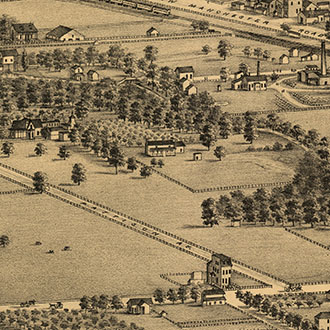
I’ve enjoyed my time in Lindenwood Park, but if I had to pick a favorite stop in St. Louis, it would be Dogtown. I first moved to Dogtown (Hi-Pointe, specifically) in 1997 when I lived in a big house on Forest Avenue with a few college friends. Two years later, I moved into my first apartment (and attempt at adulthood) at the corner of Art Hill and Oakland in Clayton-Tamm. The place was great. It was centrally located, I did my shopping at a neighborhood grocery named Gewinner’s (now the site of Heavy Riff Brewing), and I just loved the vibe of the neighborhood I was living in. I hadn’t become a St. Louis history nerd yet, but it was during those years when I started to become curious about the history of a city that seemed to be where I’d be living for a long time.
Best of all, I found myself just a stone’s throw from one of the best (and oldest) bars in St. Louis. The Pat Connolly Tavern, located at 6400 Oakland Avenue, has been a fixture in St. Louis for over seventy-five years. When I lived nearby, I often rambled over for a few beers and the best fried chicken in town. My late father, a guy who was famous for thumbing his nose at places he didn’t think were old school, thought Pat’s was perfect. When he and my mother visited me (from upstate New York), they’d always call and tell me to meet them at Pat’s after work instead of at the apartment. Even after I moved away from Dogtown, my father joked that his retirement plan was to rent the space above Pat’s and living out the rest of his days there.

So imagine my joy when the current owner of the Pat Connolly Tavern, Joe Jovanovich, contacted me last year and asked if I’d be interested in helping him tell the history of his bar as part of its 75th anniversary celebration. Joe is the grandson of the bar’s original owner Pat Connolly, an Irish immigrant who opened the tavern with his wife Mary Ellen in 1932. I jumped at the opportunity, and I soon found myself talking to a big crowd (twice) in the exact space where my Dad once hoped to retire.
Best of all, I didn’t have to do too much work to put the presentations together. St. Louis is fortunate to have the Dogtown Historical Society, an organization that has documented the history of the area in ridiculous detail. Due to the efforts of guys like Bob and John Corbett (and Joe for the bar history, of course), I had everything I needed to tell the story of Dogtown and its famous tavern.
I promised Joe I’d also get a Distilled History post out to accompany the event, and I hate to admit I let that slide. But here it is, right in time for St. Patrick’s day. Better late than never, right?

Many will say the Pat Connolly Tavern sits in Dogtown, but more specifically, Pat’s sits in the Clayton-Tamm neighborhood. Many in St. Louis already know this, but just in case, “Dogtown” is not an official city neighborhood. According to the Dogtown Historical Society, it’s an area located south of Forest Park that consists of five city neighborhoods: Hi-Pointe, Clayton-Tamm, Franz Park, Cheltenham, and the eastern section of Ellendale. Anchored by St. James the Greater Parish and home to one of the best St. Patrick’s Day celebrations in the country, Dogtown is also known as the Irish part of town. Being a descendant of an Irish immigrant myself, perhaps that explains why Dogtown feels like home to me.
But the first settler in the area was actually from Switzerland, a guy named Charles Gratiot who is credited with opening the area to development more than 200 years ago.

Gratiot was a major player in early St. Louis history. After emigrating to North America and becoming a successful fur trader in the Illinois territory, Gratiot made his move to St. Louis in 1781. He soon married Victoire Chouteau, the daughter of Pierre Laclède and Marie Chouteau (and sister of Auguste Chouteau), a union that further enhanced his influential status in the village. In 1785, Gratiot applied for a large parcel of land west of the village. After it was approved by Spanish authorities, it became known as the “Gratiot League Square”. It was an enormous piece of property consisting of over 5,700 acres, with several current city neighborhoods fitting neatly inside it.
(Note: I also wrote a bit about Gratiot and his big piece of land in my post Kingshighway’s Way)
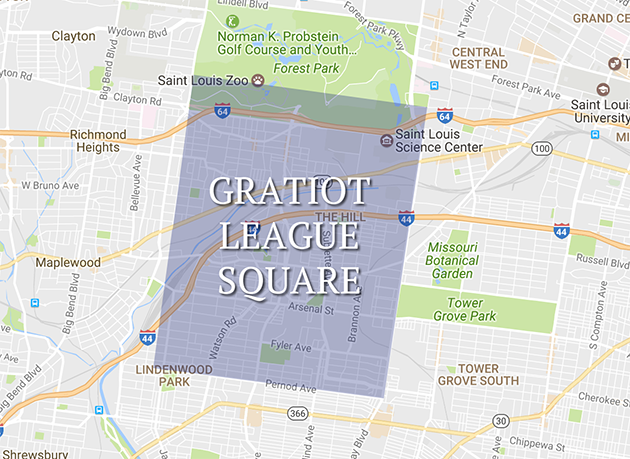
As part of the deal, Gratiot was required to cultivate his new property. Along with a big mansion near the present-day intersection of Macklind and Manchester, Gratiot built a farm, a mill, and even a distillery. He sold plots of his land to other farmers, and the area grew to become a rural farming community. During this time, the area was known as an idyllic and peaceful setting, with rolling hills, orchards, and abundant animal life. Gratiot’s land also featured a lovely stream that wound its way through the area. Once used to feed livestock and irrigate crops, it’s known today as the River des Peres.
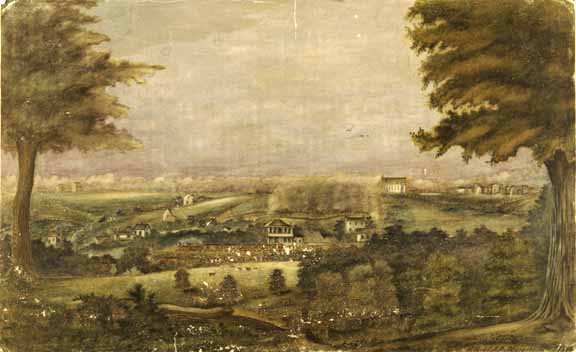
After Gratiot died in 1817, three of his children inherited the northern half of his land that would eventually become known as Dogtown. It retained its country charm throughout the first half of the 19th Century, and a nearby resort named Sulpher Springs became a prominent vacation spot in the area. Popular for its natural springs of sulpher water that many believed held medicinal properties, Sulpher Springs was a popular destination for many seeking rest and relaxation in a pastoral setting. But for one famous visitor, it’s possible the water didn’t cut it. Manuel Lisa, the first fur trader to develop the Louisiana Purchased explored by Lewis and Clark, reportedly died at Sulpher Springs in 1820.

In 1831, another famous fur trader named William Sublette bought the resort as part of a larger land purchase (779 acres) and made it his country farm. According to historian Roger Williams in an article for the Jedediah Smith Society, Sublette’s farm was quite a place. Along with a mansion and log cabins for boarders, Sublette even built his own horse race track. Sublette’s farm also featured buffalo, antelope, and even a black bear to remind him of his days in the Rocky Mountains.
But in the 1840’s the area rapidly began to change. When a concentration of coal and clay deposits (known today as the Cheltenham bed) were discovered, the area quickly shifted from an agricultural setting to an industrial one. Located just to the west of a rapidly growing city, scores of small-scale coal and clay mines popped up all over area. Along with the arrival of the Missouri Pacific Railroad, large brick factories such as Pacific Brick, Laclede Christy, and Evens & Howard began producing hundreds of thousands of high-quality bricks.

According to Bob Corbett of the Dogtown Historical Society, making bricks from clay become the central thrust of the area’s economy. Clay mining is the reason the area began to develop, and this accounted for the significant population growth and settlement in the area. And the primary group of people who led the way during this transformation in the second half of the 19th Century were immigrants.
Just as the neighborhood to the south (the Hill) became an area identified by its large Italian population, St. Louis’s large Irish community began seeking mining jobs and settling in what is now Dogtown, away from the densely populated Kerry Patch neighborhood north of downtown. They brought with them their Catholic faith (still going strong at St. James the Greater Church), their work ethic (in clay mines and other industries such as Scullin Steel), and of course, their Irish thirst. Today, places like the Pat Connolly Tavern, Seamus McDaniel’s, and Nick’s Pub carry on the tradition of feeding thirsty residents just as the Clifton Heights House, the White House, and Jack O’Shea’s did in the past.

The clay and coal mining industry is also what gave the neighborhood its now-famous name. “Dogtown” is a mining term, often used to describe a group of small huts or shelters constructed around small coal and clay deposits. This contradicts the frequently told story that the name is the result of a tribe of Igorots who stole dogs from the neighborhood for food during the 1904 World’s Fair. A 1889 article in the Missouri Republican refutes that theory, and it is the position of the Dogtown Historical Society that much of the area around Clayton and Tamm has been known as “Dogtown” since as early as the mid-1870’s.

Dogtown’s mining industry mostly died out by the 1930’s, but the impact of clay and brick is still clearly evident in the neighborhood today. The stretch of Manchester along the southern border of Dogtown (where many of the brick factories stood) still has an industrial feel to it, River des Peres is covered and is no longer the “clear crystal stream” it was once described to be, and descendants of the blue-collar, hardworking Irish that worked the mines continue to call the neighborhood home. And today, St. Louis has become famous for its brick. Few American cities can come close to the number of brick buildings and homes St. Louis has to offer.

Before I get to the drink section of this post, a reader reached out to me and expressed her disagreement with the all-Irish sentiment in this post. I normally don’t update Distilled History posts based on opinion (this is weird blog, not historical record), but in this case the comment was spot-on. I should have given more attention to the many other groups of people who have made Dogtown a great part of St. Louis over the years. Dogtown has been home to large populations of many other groups including Germans, English, Italians, Dutch, and many others. It was not my intention to diminish their impact on the area, and I apologize for the oversight. Since my post was to focus on Pat’s, and since I’m Irish myself, that’s likely where my head was at.
I also want to mention that some do not believe Cheltenham is part of Dogtown. I am aware of that debate, and I’ve heard both sides of the argument. Initially, I just wanted to avoid it. But I also personally agree with the Dogtown Historical Society that Cheltenham is Dogtown. That debate will continue, but that’s also why I think studying history can be fun.
Anyway, Dogtown has other great stories and history to offer. It was the home to memorable places such the Forest Park Highlands amusement park and the famous St. Louis Arena. Dogtown also had a front row seat for the 1904 World’s Fair, and still enjoys being the next door neighbor of one of largest urban parks in the country. The Saint Louis Zoo is literally across the street, and that fact actually provides my only Dogtown-living complaint. Living at the corner of Art Hill and Oakland meant that I had to battle Saint Louis Zoo visitors for available parking spots during every minute that I lived there.
And I was (amusingly) reminded of that last night, when had to jockey for parking when going for a drink at Pat’s to celebrate this post.
The building where the tavern stands today at 6400 Oakland Avenue dates to 1918. Originally it was a candy store and later a drug store, but an immigrant laborer living with his family in Dogtown saved up enough money to buy it. Born in 1908 in County Galway, Pat Connolly arrived in America in 1927. Along with his wife Mary Ellen, they opened the Pat Connolly Tavern in 1942.

Pat’s began as a Griesedieck Brothers Brewery bar, a common practice during a time when bars would affiliate with specific breweries. When it became an Anheuser-Busch bar in the 1950’s, the brewery spared no expense staking its claim in Dogtown. Along with installing the iconic neon V-9 Budweiser sign above the entrance (that’s still there), a team of Clydesdales delivered the tavern’s first shipment of Budweiser. It’s also believed that Pat’s was one of the first taverns or saloons in the Dogtown area to offer a full food menu. The fried chicken recipe is the same, and it’s been on the menu for almost as long as beer has been on tap.
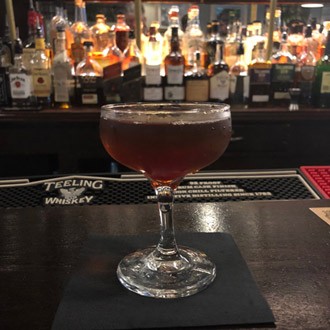
The path of Pat’s history gets interesting after the Connolly’s sold their bar in 1960. It operated as McDermott’s for the next twenty years, taking the name of the long-time bartender who bought it from the Connollys. During that time, McDermott’s became famous for its location near the St. louis arena during the rise of St. louis Blues hockey. In those years, it wasn’t uncommon to find Blues players inside downing a few cold ones after a game. The Connolly family bought the tavern back in 1980 when daughter Teresa Connolly (daughter of Pat and Mary Ellen Connolly) bought it with her husband Paul Jovanovich. They gave the tavern its old name back, and they kept the tradition going until selling the bar again to a long-time employee and family friend 1999.
That’s the time when I first lived in Dogtown and began spending time at Pat’s. Back then, I wonder if the bartenders at Pat’s ever noticed the two oddballs who came around 4 p.m. for several days in a row and ordered Manhattans. Those oddballs were my parents, and I bet they insisted their cocktails served up and stirred. After a drink or two, my Dad probably asked if the room upstairs was available to rent.

Fast-forward to 2018, I find myself sitting at the same bar, ordering the same drink, and thinking back on my days living in Dogtown. Even better, I don’t have to worry about getting the drink served properly. My new pal Joe Jovanovich, Pat Connolly’s grandson and current owner of the Pat Connolly Tavern (along with his mother Teresa), has implemented a great cocktail menu to the latest iteration of Pat’s. They bought the bar together in 2015, bringing the Pat Connolly Tavern back into the family that opened it over seventy-five years ago.
This time, let’s hope it’s for good.


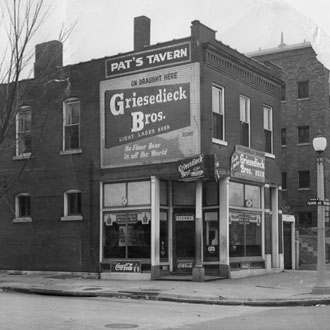
Great work, Cameron.
Wonderful history! If I’m not mistaken, a certain man named Ulysses ventured in that direction selling log beams for the mines.
Very enjoyable read, sir.
Great story! I was wondering if you were ever going to get to the part when Tom McDermott owned the Tavern. I spent many of nights drinking and eating that Fried Chicken.
We would gather there before we headed to Cahokia Racetrack with Tom who was a big betting fan.
Those were the days!
Thanks for the story!
Karen